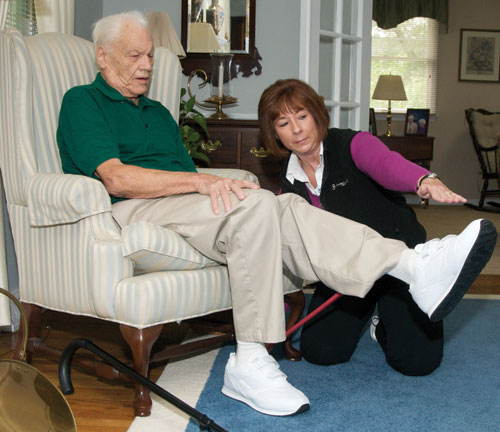Blind with broken hip, patient presents unusual rehab challenge


Much of physical therapy focuses on teaching strengthening exercises: The therapist demonstrates a movement, and the patient copies. But how do you rehabilitate a patient who is blind?
Nancy Laird, a physical-therapy assistant with Christiana Care Visiting Nurse Association, came up with a new way to teach blind patients the plan of care prescribed by their primary physical therapist after meeting Jack Haas, 84, a former DuPont employee who started losing his sight due to glaucoma in the 1980s.
Rather than despair, Haas adapted. No longer able to read, he found books on tape. With the help of his wife, Jackie, he easily adjusted and never lost his sense of humor. Then one evening he fell on the kitchen floor, breaking his hip.
Christiana Care orthopaedic trauma surgeon Craig Smucker, M.D., a childhood neighbor of Jack Haas and his family, repaired the broken hip with a steel rod and pins. After healing, Haas spent a week in Wilmington Hospital’s rehabilitation facility and then some more time recovering with support from his family in Maryland.
Moving back to their Newark, Del., home, Jackie Haas sought help from Christiana Care VNA to continue Jack’s rehabilitation. The VNA’s Laird knew that the usual methods of teaching strengthening exercises were insufficient with a patient who is blind; more and different steps are necessary.
“You have to give lots of cues,” she explains. “The first thing you do is tell the patient that you are going to touch them, and explain the motions you want them to do.”
For example, Laird would tell Haas she was going to touch his knee, then lift his knee to a certain position and return it to its original spot. She would then ask him to repeat the movement. Or Laird would ask Haas to move his leg to the left or right until his knee reached her hand. In this way, Jack knew how far in either direction to move during a given exercise.
Haas family members also learned how to help Jack do exercises accurately and safely so they could help with his recovery. Laird made Jack an audio tape, describing each exercise so that he could do them on his own. After working with Laird for two months, Haas continued his care at Christiana Care Physical Therapy PLUS. Today, it’s hard to tell that Haas had such a serious injury.
Laird says her biggest challenge in working with a sightless patient with a broken hip was Haas himself.
“Jack has no fear,” she says. “Sometimes, he actually provoked fear in me. He has lived in the same house for 40 years, so he had confidence he could get around the house alone, even when he really couldn’t.” Now, after completing rehab with Laird, he can.